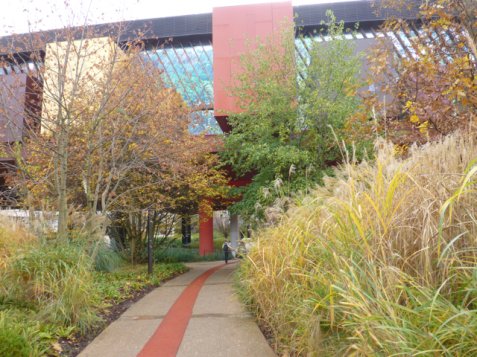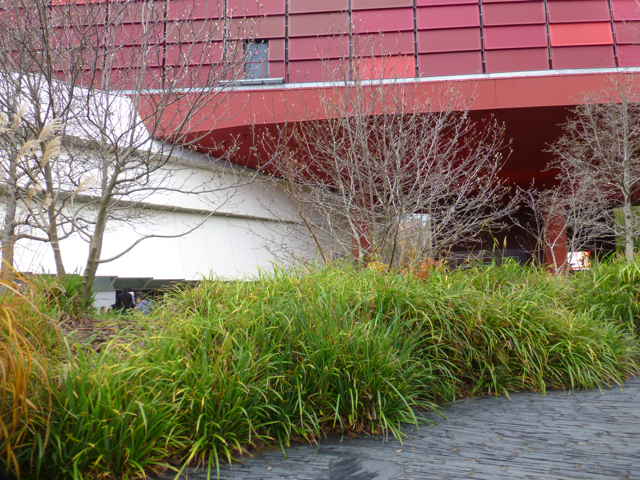 Sitting pretty by the Seine, in the 7th arrondissement, with terraces of Haussmann-order breathing down on the south side, there was a bit of a brouhaha over this plot of land. It’s nearest metro stop, Alma-Marceau is also the right one if you want to visit the Paris sewers and the Eiffel Tower which sticks up in the background like a gawky stork. Mitterrand had ambitions for an international conference centre. The locals put up a fierce fight and so it was that the site was vacant for the next president to harbour the idea of being immortalised in stone. Chirac wanted a museum to house two collections of trophies from France’s former subject nations. Take planning outrage and uncomfortable associations of the past and you have one big political hot potato. How do you order a mass of artefacts garnered by missionaries and explorers and weave this into a Republican ideal of assimilation? In 1999 there was an open competition to find an architect. The winner, Jean Nouvel, started straight in by taking note of the criticisms of the Mitterrand scheme. His model for the project was a building lower than the surrounding buildings, kept out of sight and screened from view by the new gardens.
Sitting pretty by the Seine, in the 7th arrondissement, with terraces of Haussmann-order breathing down on the south side, there was a bit of a brouhaha over this plot of land. It’s nearest metro stop, Alma-Marceau is also the right one if you want to visit the Paris sewers and the Eiffel Tower which sticks up in the background like a gawky stork. Mitterrand had ambitions for an international conference centre. The locals put up a fierce fight and so it was that the site was vacant for the next president to harbour the idea of being immortalised in stone. Chirac wanted a museum to house two collections of trophies from France’s former subject nations. Take planning outrage and uncomfortable associations of the past and you have one big political hot potato. How do you order a mass of artefacts garnered by missionaries and explorers and weave this into a Republican ideal of assimilation? In 1999 there was an open competition to find an architect. The winner, Jean Nouvel, started straight in by taking note of the criticisms of the Mitterrand scheme. His model for the project was a building lower than the surrounding buildings, kept out of sight and screened from view by the new gardens. 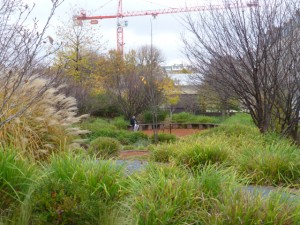 For the layout of these, he added 10 square metres to the original brief. This gave a garden area of 17,500 metres and for their design he hired Gilles Clement, landscape architect and lecturer at Versailles National School in both natural history and design. When I tell you that there is a Cameroonian butterfly named for him - Bunoepsis clementii - you begin to get the picture. He is into biological gardening and ‘le jardin en mouvement’ . The role of the gardener is to guide and enrich in sympathy and harmony with nature. Out with chemicals, watering systems and energy grinding machinery. He is a modest designer and calls himself a gardener. For several years Clement refused the French national prize for landscape architecture, insisting that the prize should go to the farmers, engineers and foresters who are the real architects of landscape. 1998 saw the French Government bestow the honour on him without his consent.
For the layout of these, he added 10 square metres to the original brief. This gave a garden area of 17,500 metres and for their design he hired Gilles Clement, landscape architect and lecturer at Versailles National School in both natural history and design. When I tell you that there is a Cameroonian butterfly named for him - Bunoepsis clementii - you begin to get the picture. He is into biological gardening and ‘le jardin en mouvement’ . The role of the gardener is to guide and enrich in sympathy and harmony with nature. Out with chemicals, watering systems and energy grinding machinery. He is a modest designer and calls himself a gardener. For several years Clement refused the French national prize for landscape architecture, insisting that the prize should go to the farmers, engineers and foresters who are the real architects of landscape. 1998 saw the French Government bestow the honour on him without his consent. 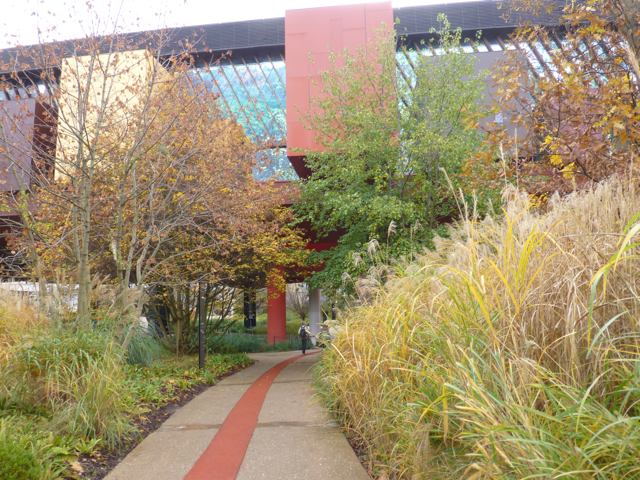 As to Museum du Quai Branly, the building is constructed as a huge bridge rising 10 metres above the garden supported by two large concrete silos at east and west ends. It stands propped on 26 steel columns. Once the planting grows up, the columns will disappear and give the impression that the edifice is resting on the tree tops. Nearly 10 years on this intent is beginning to show. In winter the bare branches and swelling buds give crisp pale silhouettes against powder-red steel. Clement ‘s masterplan is the exact opposite of a formal French garden. You will find no vistas, no fences, no lawn, no gates and no sweeping stairway. Instead it is a tapestry of small gardens, hills, pools and groves. Paths meander and seemingly lead no-where other than into little individual gardens and resting places.
As to Museum du Quai Branly, the building is constructed as a huge bridge rising 10 metres above the garden supported by two large concrete silos at east and west ends. It stands propped on 26 steel columns. Once the planting grows up, the columns will disappear and give the impression that the edifice is resting on the tree tops. Nearly 10 years on this intent is beginning to show. In winter the bare branches and swelling buds give crisp pale silhouettes against powder-red steel. Clement ‘s masterplan is the exact opposite of a formal French garden. You will find no vistas, no fences, no lawn, no gates and no sweeping stairway. Instead it is a tapestry of small gardens, hills, pools and groves. Paths meander and seemingly lead no-where other than into little individual gardens and resting places. 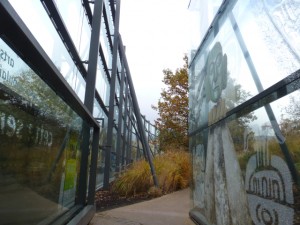 Approaching from the Seine, the visitor enters the garden through a gap in an engraved glass wall that deadens the noise of traffic along the embankment. An oasis opens up and embraces, swirling the visitor on and round, below, through and out beyond the museum. Hardy and native plants have been used with a glut of grasses and multi-stemmed trees. The hard-landscaping materials are riven slate, hoggin, wood, slate chips, stone set in concrete and wood chips - it all has a delightful randomness which is compounded by the scaping of the ground into hills and hollows. There are several outdoor rooms and it was the sun shelter of rambling roses supported on rusty reinforcing rods which really made me smile. I have a weakness for reinforcing rods as cheap and as good looking a piece of fake Corten steel that you could hope for. The boldness and simplicity of the planting pulls it all together.
Approaching from the Seine, the visitor enters the garden through a gap in an engraved glass wall that deadens the noise of traffic along the embankment. An oasis opens up and embraces, swirling the visitor on and round, below, through and out beyond the museum. Hardy and native plants have been used with a glut of grasses and multi-stemmed trees. The hard-landscaping materials are riven slate, hoggin, wood, slate chips, stone set in concrete and wood chips - it all has a delightful randomness which is compounded by the scaping of the ground into hills and hollows. There are several outdoor rooms and it was the sun shelter of rambling roses supported on rusty reinforcing rods which really made me smile. I have a weakness for reinforcing rods as cheap and as good looking a piece of fake Corten steel that you could hope for. The boldness and simplicity of the planting pulls it all together. 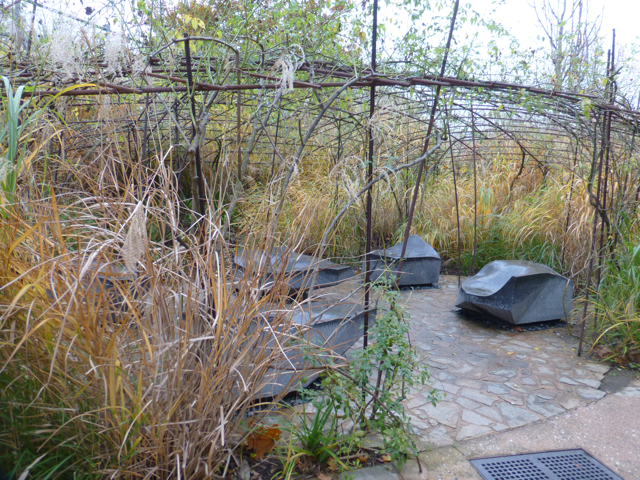 Further round the corner on the Seine-side there is a crazy knitted tapestry of 800 vertical square metres. The planting composition is of 15,000 plants gathered from Central Europe, Japan, China and the Americas. None of the Clement restraint in palette but as you crick your neck up to get a better look, it is easy to see why this vertical wall composed and executed by Patrick Blanc has made him famous. No doubt it has rashes of colour in the flowering season. Seen in winter it is a harmonious green sheet of different textures from smooth mosses to fluffy ericas.
Further round the corner on the Seine-side there is a crazy knitted tapestry of 800 vertical square metres. The planting composition is of 15,000 plants gathered from Central Europe, Japan, China and the Americas. None of the Clement restraint in palette but as you crick your neck up to get a better look, it is easy to see why this vertical wall composed and executed by Patrick Blanc has made him famous. No doubt it has rashes of colour in the flowering season. Seen in winter it is a harmonious green sheet of different textures from smooth mosses to fluffy ericas. 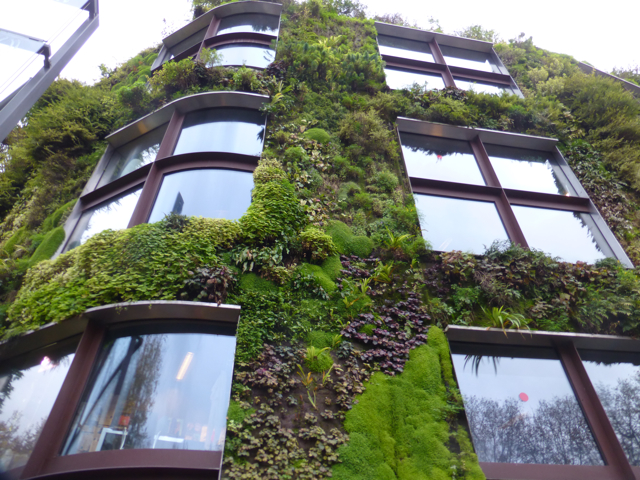 A few words about Quai du Branly itself - the critics had a field-day when the museum first opened in 2006. There was always going to be a tension between anthropology and aesthetics. The interior and the display were down to Nouvel’s judgement and the dimly lit displays, that are approached up a leather-clad corridor brought down a fire-storm of derision. I like the complaint from the NYT critic who likened it to visiting a discotheque at 10am in the morning. Make a visit and get a feel for the work of Clement - also to be found in Paris at Parc Andre Citroen and at the Jardins de la Grande Arche de la Defense.
A few words about Quai du Branly itself - the critics had a field-day when the museum first opened in 2006. There was always going to be a tension between anthropology and aesthetics. The interior and the display were down to Nouvel’s judgement and the dimly lit displays, that are approached up a leather-clad corridor brought down a fire-storm of derision. I like the complaint from the NYT critic who likened it to visiting a discotheque at 10am in the morning. Make a visit and get a feel for the work of Clement - also to be found in Paris at Parc Andre Citroen and at the Jardins de la Grande Arche de la Defense.
